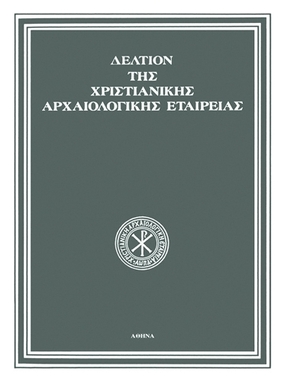Άγνωστο έργο του Θεοφάνη του Κρητός στα Μετέωρα
Part of : Δελτίον της Χριστιανικής Αρχαιολογικής Εταιρείας ; Vol.40, 2001, pages 357-364
Issue:
Pages:
357-364
Parallel Title:
An Unknown Work by Theophanis the Cretan at Meteora
Section Title:
Articles
Abstract:
Housed in the sacristy of the Barlaam monastery atMeteora is an icon of the Dormition of the Virgin and anicon of the Crucifixion, both of which belonged originally toa two-sided icon which was venerated the Byzantine churchof the Dormition of the Virgin at Kalambaka, until its theftfrom there in 1979. It was located abroad in 1983 andrepatriated after successful litigation in 1986, first into thecustody of the Byzantine and Christian Museum, Athensand then of the Barlaam monastery. Unfortunately theantiquities thieves had separated the two sided icon of theDormition of the Virgin and the Crucifixion into two, withserious consequences for the earlier representation of theCrucifixion, work of a North Greek workshop of the secondhalf of the fourteenth century.In 1992 the icon of the Dormition of the Virgin, like that ofthe Crucifixion, was conserved in the Byzantine MuseumAthens and linked with the artistic activity of Theophanis'sson, Neophytos, who in 1573 collaborated with the priestKyriazis on the decoration of the church of the Dormition ofthe Virgin at Kalambaka. However, careful examination ofthe icon of the Dormition of the Virgin leads us to ascribe itto the artistic activity of Theophanis the Cretan at Meteora.The iconography of the icon of the Dormition of the Virgin,as well as the composition with its austere, compact format,in which the figures are included with balance and symmetry, follows faithfully with minimal deviations, the iconography and composition of the Dormition of the Virgin inthe wall-paintings in the katholikon of the monastery of StNicholas Anapavsas (1527).The 'closed', individual faces on which the deeply melancholic expression is registered without intensity, the émanant spirituality and mien of the figures are basic characteristics of both the portable icon formerly in the Kalambakachurch and the wall-painting in the Anapavsas monastery,and are distinctive traits of the artist who created them.In our view the iconography, composition and artistic idiomof the icon associate it with the work of Theophanis theCretan and place it in the period during which he wasworking on the decoration of the katholikon of the Anapavsas monastery at Meteora (1527). It seems that the ecclesiastical dignitaries of the metropolis church at Kalambakacommissioned the great artist to paint the icon in the churchat that time.Further, bearing in mind that the earlier icons attributed toTheophanis - not without objections - are two despotic iconsand eleven icons of the Dodecaorton in the Great Lavramonastery, which are dated indirectly to 1535, then the iconof the Dormition of the Virgin from the homonymouschurch at Kalambaka, nowadays kept in the Barlaam monastery, is the earliest surviving icon that can be attributedconfidently to Theophanis and consequently dated to 1527.On the other hand, a close iconographie and artistic affinitybetween the Kalambaka icon and icons of the Dormition ofthe Virgin that are attributed to Andreas Ritzos or linkedwith the art of his workshop is observed. These elementspoint to Theophanis's dependence on the workshop of thatgreat artist of the Cretan School during the second half ofthe fifteenth century.
Subject:
Subject (LC):




